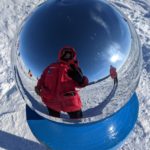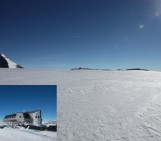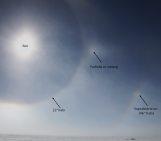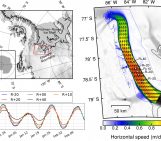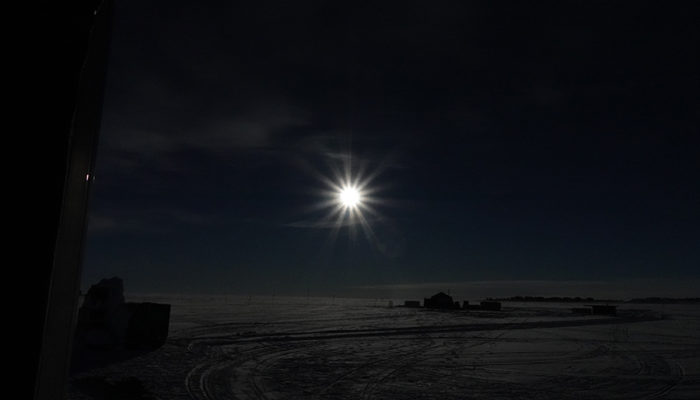
On 04 December 2021, only a handful of people in Antarctica were fortunate enough to experience a total eclipse. As well as spectacular views—including a brief window of totality that darkened the midnight sun for 2 minutes—this phenomenon is known to affect the flow of energy between the Northern and Southern hemispheres of the ionosphere. Because eclipses in Antarctica only happen once every ~20 years, space scientists were eager to use this rare opportunity to investigate how eclipses affect the properties of the ionosphere.
What happens during an eclipse?
During a total solar eclipse, the shadow of the moon sweeps across the Earth’s atmosphere. The decrease in solar radiation within the shadow affects the ionized portion of the Earth’s upper atmosphere – the ionosphere – in a variety of ways. Space scientists have been making use of GNSS data collected by the cryosphere research community to study these effects during the 4 December 2021 Antarctic solar eclipse. This follows a growing trend of using GNSS receivers to understand space weather that can affect a wide range of spaceborne and ground-based technology. These receivers collect information that can be used to infer the “Total Electron Content” (or “TEC”) along a line of sight between the receiver and different GNSS satellites. When multiple satellite-receiver pairs are available, it’s possible to resolve 2D and 3D structures in the ionosphere.
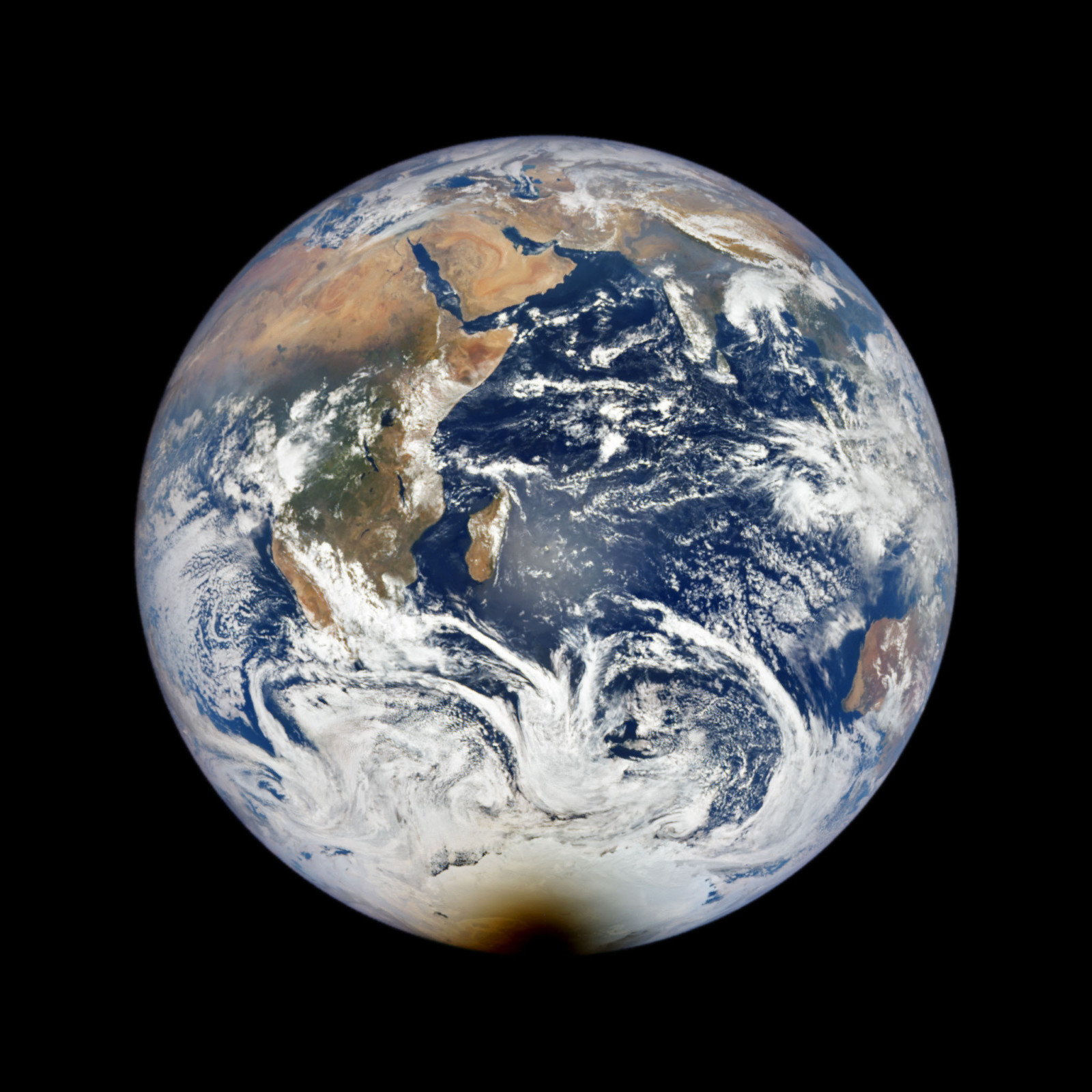
Polar eclipses create a north-south hemisphere asymmetry in sunlight that in turn creates an asymmetry in the ionosphere. Credit: NASA Earth Observatory/EPIC/DSCOVR.
An international collaboration to investigate the 2021 Antarctic Eclipse
The 4 December 2021 eclipse across the Antarctic continent presented a rare opportunity to conduct a natural experiment examining how electrical currents in the near-Earth space environment flow between the northern and southern polar regions, adjusting themselves to north-south hemisphere asymmetries in the ionosphere caused by the eclipse. To take full advantage of this opportunity, space scientists needed to fill a measurement gap in West Antarctica, where few instruments are currently deployed to study space weather. Fortunately, the cryosphere research community have this area well-covered, with GNSS receivers from the A-NET, POLENET, and UKANET projects deployed on outcrops across the continent to study the solid Earth response to ice loss. Due to the logistical challenges of visiting the instruments, they have recently been equipped with iridium modems to enable real-time data transfer and remote monitoring of ice loss. Crucially, this also provides a means to communicate with the instruments and change the sampling rate (number of measurements taken per unit of time) if it turns out this would be useful for researchers working in other disciplines.

Magnetometer/GNSS deployment at Mount John’s, just before the 4 Dec 2021 Antarctic Eclipse. Photo credit: British Antarctic Survey.
As part of an international and interdisciplinary collaborative effort, cryosphere and space weather researchers began planning a measurement campaign in early 2020 to take full advantage of these and other resources to study the ionospheric response to the eclipse. In a series of telecons, plans were made for the British Antarctic Survey to deploy a magnetometer (magnetic fields are used to remote sense ionospheric currents) to the path of totality, co-located with a pre-existing UKANET GNSS receiver. In parallel, engineers at UNAVCO – a NSF-funded geodetic facility – spearheaded plans for co-ordinated messages to be sent out to GNSS receivers across the continent, instructing them to increase the sampling rate from 30s to less than 10s to support eclipse investigations of ionospheric wave activity. At the same time, researchers repaired magnetometer/GNSS systems in East Antarctica needed to study the global effects of the eclipse. Despite multiple weather delays in November 2021, the field teams were able to deploy and service the instruments in time for the eclipse.

Total Electron Content (TEC) during the 4 December 2021 eclipse. Blue color indicates reductions in TEC, with significant reductions seen over West Antarctica during the peak obscuration (middle panel). Figure credit: Shunrong Zhang. A movie of the TEC evolution during the eclipse can be viewed here.
First results from the natural experiment
We know from past eclipses that the TEC in the ionosphere decreases during an eclipse as the reduction in sunlight decreases photo-ionization rates. This image and related movie show the first results of this effect over West Antarctica during the 2021 eclipse. Researchers are continuing to incorporate additional data into these maps. Using similar TEC data, they hope to understand asymmetries between the northern and southern hemispheres during this event and, more broadly, how asymmetries in the near-Earth space environment affect the ionosphere and space weather. GNSS data collected by the cryosphere research community is critical for understanding space weather, particularly over West Antarctica and other regions of Earth where there are few instruments deployed by space scientists.
Further reading:
- Aa et al. (2022) 3-D Regional Ionosphere Imaging and SED Reconstruction With a New TEC-Based Ionospheric Data Assimilation System (TIDAS). Space Weather 20(4): e2022SW003055
- Coster, A. et al. (2017) GNSS Observations of Ionospheric Variations During the 21 August 2017 Solar Eclipse. Geophysical Research Letters 44(24): 12041-12048
- Lipuma, L. (2021) Scientists prepare for rare Antarctic solar eclipse. The Antarctic Sun
Edited by T.J. Young and Marie Cavitte
Michael Hartinger is a Research Scientist at Space Science Institute (USA) who studies space weather and magnetosphere-ionosphere coupling, including north-south hemisphere asymmetries. He’s the Principal Investigator of the NSF-NERC project to study hemispheric asymmetries related to the December 2021 eclipse and other geospace phenomena using a network of autonomous instrument platforms.
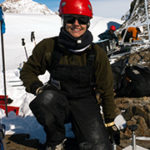 Pippa Whitehouse is an Associate Professor in the Department of Geography at Durham University where she studies feedbacks between ice dynamics, sea-level change and Earth deformation. She leads the NERC-funded UKANET project, overseeing GNSS data collection from ~30 instruments across West Antarctica for the purpose of quantifying ice sheet change and mantle viscosity. She tweets as @AntarcticPippa.
Pippa Whitehouse is an Associate Professor in the Department of Geography at Durham University where she studies feedbacks between ice dynamics, sea-level change and Earth deformation. She leads the NERC-funded UKANET project, overseeing GNSS data collection from ~30 instruments across West Antarctica for the purpose of quantifying ice sheet change and mantle viscosity. She tweets as @AntarcticPippa.
 Mervyn Freeman is Senior Space Weather Researcher and the Leader of the Space Weather and Atmosphere Team at the British Antarctic Survey. He’s the Principal Investigator of the BAS Low Power Magnetometer Network, and he coordinated the deployment of a magnetometer to the 2021 eclipse’s path of totality.
Mervyn Freeman is Senior Space Weather Researcher and the Leader of the Space Weather and Atmosphere Team at the British Antarctic Survey. He’s the Principal Investigator of the BAS Low Power Magnetometer Network, and he coordinated the deployment of a magnetometer to the 2021 eclipse’s path of totality.
Shane Coyle is a PhD Candidate at Virginia Tech where he studies Magnetosphere-Ionosphere coupling. He operates and maintains the AAL-PIP array of magnetometer stations on the East Antarctic Plateau and is a member of the PyDARN development team.
Terry Wilson is a Professor of Earth Sciences at Ohio State University and Principal Investigator of the NSF POLENET project. Her research includes the structural architecture of the Earth, how continents rift, and the interaction of the solid Earth and ice sheets in Antarctica.
Shunrong Zhang is a Space Scientist at the MIT Haystack Observatory. He studies ionosphere and thermosphere coupling and geospace disturbances, upper atmospheric climatology, variability and long-term trends. He frequently uses TEC to study these phenomena.


